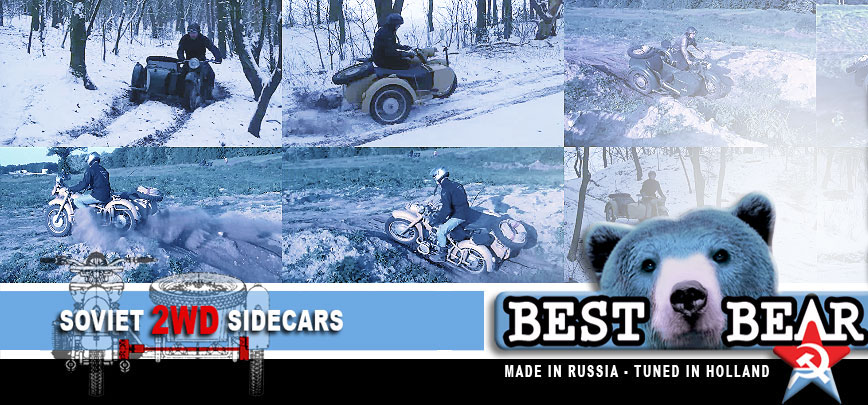|
On
the road and off-road
We especially like our 2-wheel-drive
Dneprs under off-road circumstances because then their features
turn out best, but they function very well on the road as
well. The driven sidecar even makes it an easier to handle
combination than a normal not-driven sidecar, because the
drive on the second wheel makes steering easier and its higher
weight results in better stability.

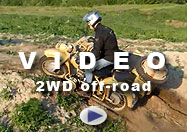


Differential and its locking device
To ride on paved surface with a driven
sidecar you need a differential, quite the same as with a
car. The differential distributes the power over the two driven
wheels so that the wheel following the outer circle of the
bend gets more power and revolves faster. Without this it
would be almost impossible to steer on a surfaced road.
When a differential is locked, i.e. both driven wheels receive
the same amount of power, the wheel following the inner circle
of the bend has to be able to slip, this is only possible
on a loose or slippery (icey) surface. A locked differential
acts as a rigid axle, and makes steering imprecise.
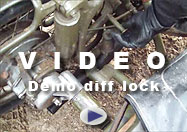

Caution!
Some of our driven sidecar machines are
equipped with a locking device on the differential; NEVER
engage this on a surfaced road! On surfaced roads the vehicle
can only ride in a straight line when the differential is
locked, no matter what you (try to) do with the front wheel!
Even in terrain the steering is imprecise. This locking device
is only meant to be used when you are stuck in soft or icey
terrain; one driven wheel is blocked while the other one slips
and direction of move is less important than any movement
at all.
Therefore you only lock a differential when riding off-road
to overcome a particulair situation, just to get you on the
move again. Be carefull, riding on the road with a locked
differential is useless and DANGEROUS!
Reverse
Specially for a sidecar combination a
reverse is a welcome addition. Shifting to reverse is only
possible when the gearbox is in it's neutral position. The
video below explains the operation.
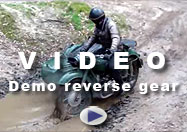

Caution!
Be careful when riding the machine in
reverse! If this is done too fast control over the steering
is surprisingly easy lost and the forces provoked thus are
immense. This is normal because the combination is designed
for straight on stability in forward direction, not in reverse
and you can’t have that both ways.
|
|
Climbing or descending
While riding off-road in sloping terrain
for safety try to keep the sidecar at the lower end if possible,
especially when it is empty.
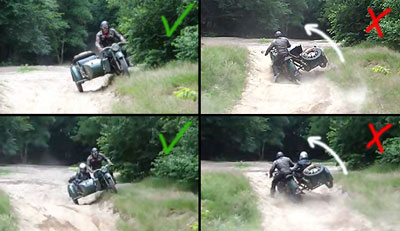
Caution!
Slooping terrain is never a save situation
and needs constant concentration.
Corners
Another feature to be aware of when riding
a driven sidecar combination is to keep the sidecar wheel
in contact with the road surface, especially while taking
corners to the right. Slow down before the bend sets in! If
the sidecar lifts (which is not unusual with conventional
lighter sidecars) its driven wheel will start to spin while
traction on the bike’s rear wheel declines; this is
the normal working of the differential. Beware that things
can get out of hand when the spinning sidecar wheel touches
the road surface again and tries to force the whole vehicle
suddenly to the left. The best thing to do if the sidecar
starts to lift in a right bend is to close the throttle and
withdraw the clutch while moving your body-weight towards
the sidecar. Only release the clutch while gently opening
up the throttle when the sidecar wheel is in full contact
with the road surface again.
In corners to the left the driven sidecar has the big advantage
of a much better control over the vehicle in case it starts
sliding, especially on wet or slippery roads.
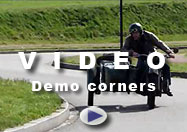

Overheating
If it occurs that the engine, especially
a flathead type, seems to lack power progressively during
a longer ride in extremely heavy terrain or prolonged steep
climbes this is problaby due to overheating. Side valve engines
easilly generate heat, sometimes causing the (modern) fuel
in the float chambers to boil which leads to instable gas
mixture, which in turn accelerates the overheating of the
engine.
Stop the engine and let it cool down for half an hour or so.
It is in their nature that side-valve
engines tend to run quite a bit hotter, which makes maintaining
tappet clarence all the more important.
Also keep in mind that these engines basically date from the
1930’s, an era in which prolonged high speed cruising
wasn’t possible, due to the infrastructure of that time.
Cruising speeds of about 50 mph were considered normal and
most engines were developed for just that, and yes, this one
was too. If you just take your time and vary the engine load
sufficiently it will take you almost anywhere in the world,
whether there is a road or not.
When off-road riding, be prepaired for
the unexpected
One of the nicest things is looking for
the limits of man and machine. But under those circumstances
unexpected things will easily happen. So always think ahead:
will it be safe, what cán you expect, what will you
do, will you get out, etc. In fact: will you get home.
Always be prepaired, have shovel and rope on board, a helping
hand is always welcome so take a passenger with you, or better,
another 2WD sidecar to help you out when needed.
Have a look at the video below to see
what happened to us in well known terrain, but in a newly
dug pit with treacherous sand. Part of the off-road fun.
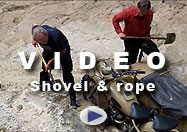

|
|
